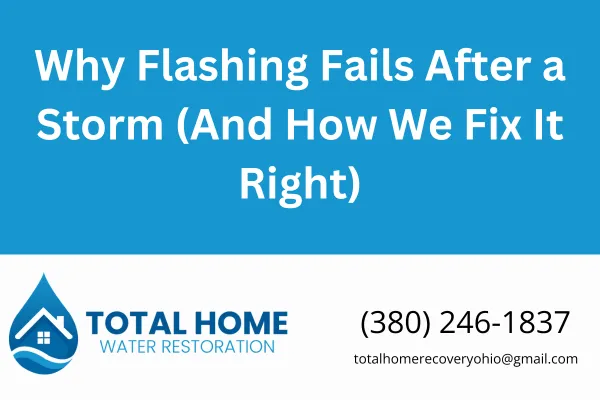
Why Flashing Fails After a Storm (And How We Fix It Right)
Why Flashing Fails After a Storm (And How We Fix It Right)
When a storm blows through Grove City or anywhere around Columbus, it's not just shingles that take a hit. Flashing—the metal sealing around chimneys, valleys, vents, and edges—often fails without you even noticing, until water starts leaking into your ceiling or walls.
As someone who's been in hundreds of attics and crawlspaces after storms, I’ll tell you: flashing failure is one of the top culprits of post-storm water damage. And it’s often a result of poor installation, not just the weather.
Here’s why flashing fails—and what we do to fix it right.
What Is Flashing, and Why Does It Matter?
Flashing is the thin metal (usually aluminum or galvanized steel) that seals joints and transitions in your roof. It’s your first line of defense against water intrusion where shingles can’t do the job alone—like:
Around chimneys
Along valleys where two roof planes meet
At skylights, vents, and pipes
At roof edges and step-ups
When flashing is properly installed and sealed, it can last decades. But one strong storm can reveal weak spots fast.
5 Common Reasons Flashing Fails After a Storm
1. Improper Installation
We see this all the time. Builders or unlicensed roofers slap in flashing with roofing cement or nails in the wrong spots. That works for a little while… until heavy rain and wind pull it apart.
2. Sealant Failure
Over time, UV rays and temperature changes crack and dry out the sealants around flashing. Once they break down, water gets in.
3. Wind-Driven Rain
High winds push rain sideways or even upward. That forces water behind improperly sealed flashing—especially in valleys or under lifted shingles.
4. Rust and Corrosion
Galvanized steel flashing that’s scratched or exposed can rust. We’ve seen flashing rot through completely, leaving a clear path for water.
5. Nail Pops or Structural Shifts
Storms can shake things up—literally. Settling, shifting, or expansion can cause flashing nails to pop or joints to separate, opening the door to water.
How We Fix Flashing Right—The Total Home Way
At Total Home Water Restoration, we don’t just slap on caulk and call it good. Here’s what we do instead:
Step 1: Full Inspection
We check all flashing points on your roof. Not just where you see a leak—but where one could start next storm.
Step 2: Tear Out Bad Flashing
If it’s bent, rusted, loose, or improperly sealed, it’s coming out. We don’t cut corners—because we’ve seen what happens when people do.
Step 3: Code-Compliant Replacement
We install new flashing that meets Ohio Building Code standards—step flashing, counter-flashing, or valley metal, depending on location. Always with proper overlap, fastener placement, and sealant per manufacturer specs.
Step 4: Water Testing (If Needed)
If you've already had a leak, we can simulate heavy rain to confirm the repair is watertight—before the next storm hits.
Step 5: Documented Repair with Photos
So you—and your insurance company—know the job was done right.
Why Homeowners Trust Us
We’re not just another roofing crew. We’re licensed, insured, and local—based right here in Grove City. We know what storms in Central Ohio do to homes, and we fix every one like it’s our own.
Need flashing repair after a storm? Don’t wait. Call Tyler Zimmerman and the team at:
Total Home Water Restoration
📍 4141 Hoover Rd, Grove City, OH 43123
📞 380-246-1837
From disaster to done right—we’ll make sure your roof’s ready for the next storm.
FAQ: Flashing Repair After Storms
How can I tell if my flashing is leaking?
Look for water stains on ceilings near chimneys or walls, or bubbling paint. Sometimes, leaks are only visible in the attic.
Can flashing be reused after storm damage?
Usually not. Once it’s been bent, rusted, or lifted, it can’t be relied on. We replace it with new, properly sealed flashing.
Will insurance cover flashing repair?
Often, yes—if it was damaged in a covered storm event. We provide documentation and work directly with your adjuster.
